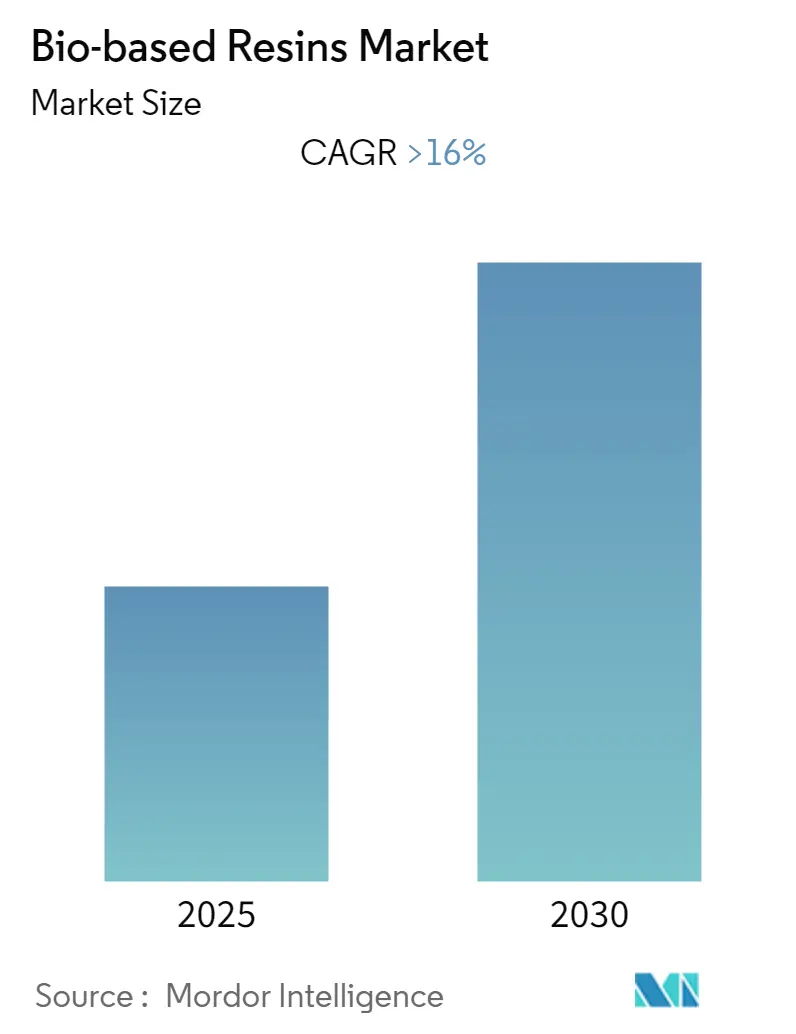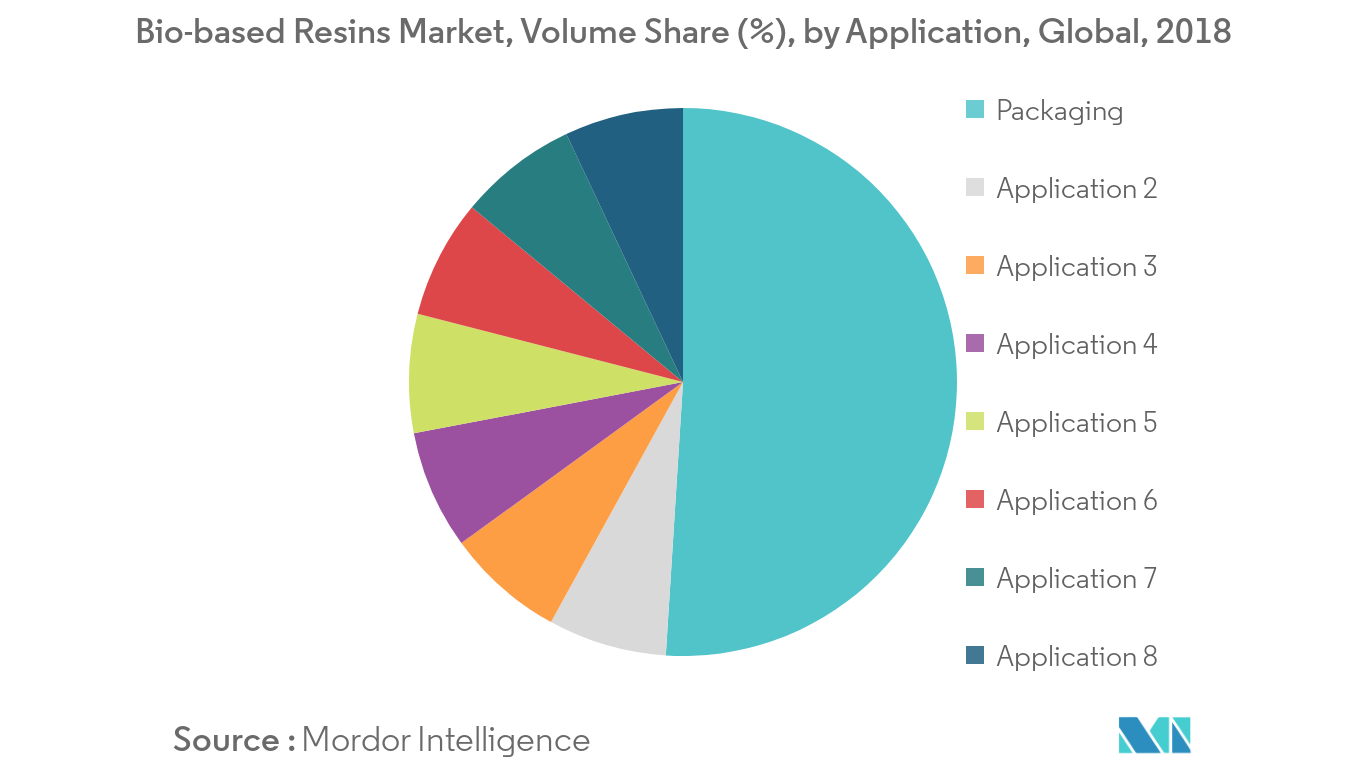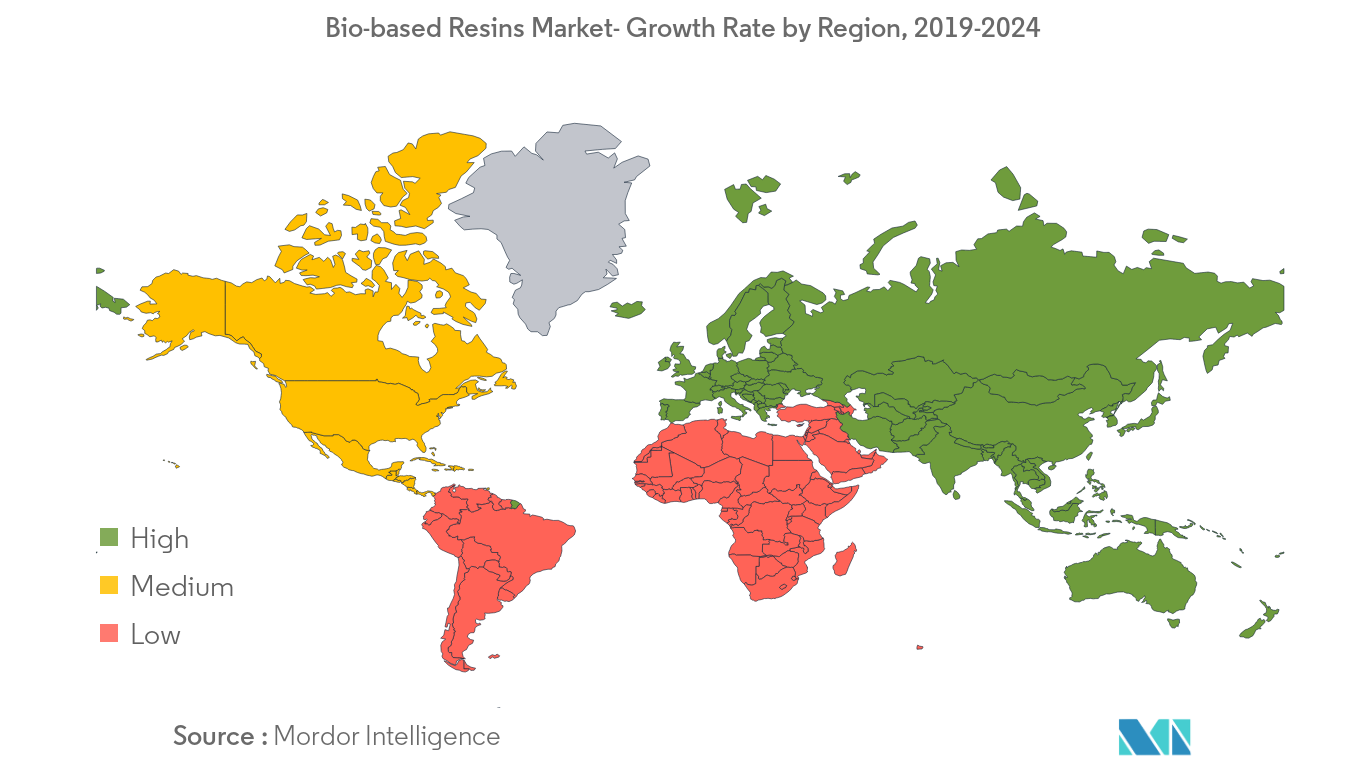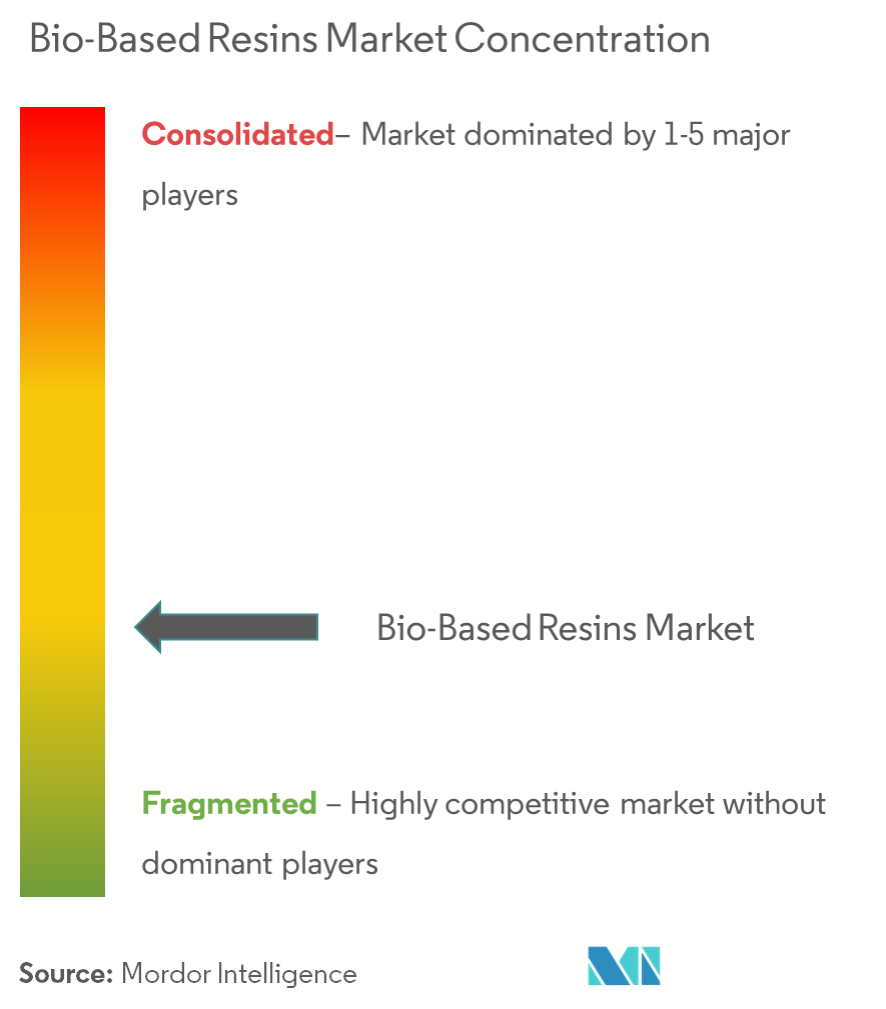Bio-based Resins Market Size and Share

Bio-based Resins Market Analysis by Mordor Intelligence
The Bio-based Resins Market is expected to register a CAGR of greater than 16% during the forecast period.
- The packaging segment dominated the market. It is likely to grow during the forecast period, owing to the growing environmental concerns related to the disposal of packaging materials, and the need for eco-friendly packaging.
- The availability of cheaper alternatives is likely to provide opportunities for the market studied, during the forecast period.
Global Bio-based Resins Market Trends and Insights
Flexible Packaging Segment to Dominate the Market Demand
- Bioplastics made from bio-based resins provide the packaging industrywith a renewable sustainable option,for a variety of uses. Within packaging, rigid packaging accounts for the larger share of the market.
- The large share is due to its usage in a large variety of products, including bottles, jars, canisters, cups, buckets, containers, trays, and clamshells.
- A majority of bio-based rigid packaging products are made of bio-based, non-biodegradable PE and PET. Additionally, PLA, PBS, and PHA plastics can offer an add-on functionality of biodegradability to rigid packaging applications.
- For instance, bio-PLA’s application in flexible packaging offers properties, such as high clarity, stiffness, and excellent printability. These properties make it highly suitable for applications in flexible packaging films made from bio-PLA resin.
- The growing food andbeverage companies and innovation in the packaging industry havebeen driving the growth of the flexible packaging market, owing to its lightweight, comparatively lower cost than rigid packaging, and ease in changing the packaging sizes.
- Regions, such as North America and Europe, have stringent regulations forthe packaging industry, in order to avoid the usage of harmful materials in packaging. Owing to this, the use of bio-based materials has been increasing in the packaging industry, in these regions.
- Moreover, in the Asia-Pacific region, the flexible packaging industry has been witnessing strong growth, due to the robust growth of e-retail, growing manufacturing sector, and increased adoption of flexible packaging, due to its lightweight.
- Asia-Pacific has been facing severe issues related to the disposal of petroleum-based, non-biodegradable packaging materials, which is further leading to a shift towardeco-friendly raw materials, such as bio-based resins, for application in the packaging industry.
- Hence, all such factors are likely to drive the demand for bio-based resins from the flexible packaging market, during the forecast period.

Germany to Dominate the Europe Region
- Germany dominated the Europe market share. The growth of bio-based resins market is expected to be driven by the growing demand from industries, such as packaging, electronics, consumer goods, agriculture, etc.
- Germany is expected to lead the market demand for bio-based resins owing to the growing application and demand from various end-user industries.
- The packaging industry in Germany has been growing at a rapid pace, owing to the huge increases in domestic e-commerce and rising foreign exports. In addition, the increasing preference for packaged food and beverages has also led to the growth of the packaging industry. Hence, the positive development in the packaging industry is expected to contribute to the demand for bio-based resins market.
- The German electronics industry is Europe’s biggest of its kind, and the fifth-largest, worldwide. The electrical and electronics industry accounted for about 11% of the total German industrial production. Besides, electronic production is also expected to increase in countries such as the United Kingdom, France, and Italy, which is likely to add to the demand for bio-based resins market.
- In Germany, the construction sector has been witnessing growth due to rising residential construction and government spending on infrastructure development, which is further expected to drive the demand for bio-based resins market in the coming years in the region.
- Hence, all such market trends are expected to drive the demand for bio-based resins market during the forecast period.

Competitive Landscape
The bio-based resins market is fragmented in nature, with numerous players holding an insignificant share of the market, to individually affect the market dynamics. Some of the noticeable players in the market include Ashland Performance Materials, BASF SE, Braskem, Arkema, and DuPont, among others.
Bio-based Resins Industry Leaders
-
Ashland Performance Materials
-
BASF SE
-
Braskem
-
Arkema
-
DuPont
- *Disclaimer: Major Players sorted in no particular order

Global Bio-based Resins Market Report Scope
The scope of the bio-based resins market report includes:
| Biodegradable Starch Blends |
| Polylactic Acid (PLA) |
| Bio-polyethylene Terephthalate (Bio-PET) |
| Polyhydroxyalkanoate (PHA) |
| Bio-polyethylene (Bio-PE) |
| Biodegradable Polyesters |
| Other Types |
| Packaging | Rigid |
| Flexible | |
| Textiles | |
| Consumer Goods | |
| Automotive and Transportation | |
| Agriculture and Horticulture | |
| Building and Construction | |
| Electrical and Electronics | |
| Other Applications |
| Asia-Pacific | China |
| India | |
| Japan | |
| South Korea | |
| Rest of Asia-Pacific | |
| North America | United States |
| Canada | |
| Mexico | |
| Europe | Germany |
| United Kingdom | |
| France | |
| Italy | |
| Rest of Europe | |
| South America | Brazil |
| Argentina | |
| Rest of South America | |
| Middle East & Africa | Saudi Arabia |
| South Africa | |
| Rest of Middle East & Africa |
| Type | Biodegradable Starch Blends | |
| Polylactic Acid (PLA) | ||
| Bio-polyethylene Terephthalate (Bio-PET) | ||
| Polyhydroxyalkanoate (PHA) | ||
| Bio-polyethylene (Bio-PE) | ||
| Biodegradable Polyesters | ||
| Other Types | ||
| Application | Packaging | Rigid |
| Flexible | ||
| Textiles | ||
| Consumer Goods | ||
| Automotive and Transportation | ||
| Agriculture and Horticulture | ||
| Building and Construction | ||
| Electrical and Electronics | ||
| Other Applications | ||
| Geography | Asia-Pacific | China |
| India | ||
| Japan | ||
| South Korea | ||
| Rest of Asia-Pacific | ||
| North America | United States | |
| Canada | ||
| Mexico | ||
| Europe | Germany | |
| United Kingdom | ||
| France | ||
| Italy | ||
| Rest of Europe | ||
| South America | Brazil | |
| Argentina | ||
| Rest of South America | ||
| Middle East & Africa | Saudi Arabia | |
| South Africa | ||
| Rest of Middle East & Africa | ||
Key Questions Answered in the Report
What is the current Bio-based Resins Market size?
The Bio-based Resins Market is projected to register a CAGR of greater than 16% during the forecast period (2025-2030)
Who are the key players in Bio-based Resins Market?
Ashland Performance Materials, BASF SE, Braskem, Arkema and DuPont are the major companies operating in the Bio-based Resins Market.
Which is the fastest growing region in Bio-based Resins Market?
Asia Pacific is estimated to grow at the highest CAGR over the forecast period (2025-2030).
Which region has the biggest share in Bio-based Resins Market?
In 2025, the Europe accounts for the largest market share in Bio-based Resins Market.
What years does this Bio-based Resins Market cover?
The report covers the Bio-based Resins Market historical market size for years: 2019, 2020, 2021, 2022, 2023 and 2024. The report also forecasts the Bio-based Resins Market size for years: 2025, 2026, 2027, 2028, 2029 and 2030.
Page last updated on:
Bio-based Resins Market Report
Statistics for the 2025 Bio-based Resins market share, size and revenue growth rate, created by Mordor Intelligence™ Industry Reports. Bio-based Resins analysis includes a market forecast outlook for 2025 to 2030 and historical overview. Get a sample of this industry analysis as a free report PDF download.


